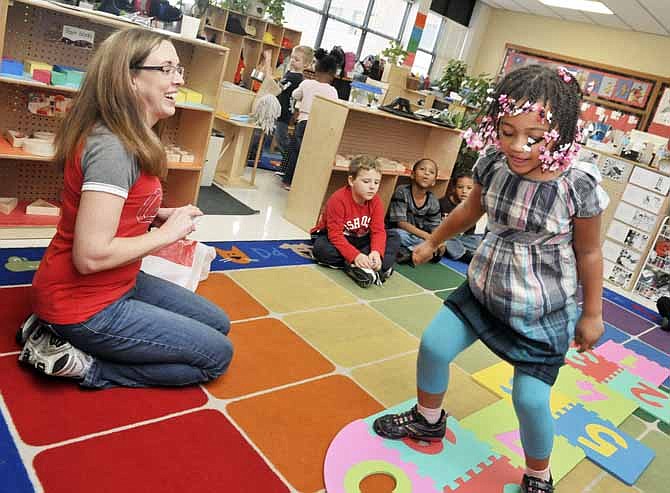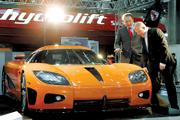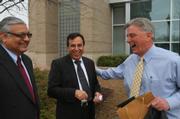As she cracked open the can of Pepsi and struck a match, the preschool teacher quizzed her small students. She held the match up to her lips, long enough to warm her fingertips before blowing it out. She lighted a second match and lowered it down to the surface of the effervescent soda.
"What's going to happen?" asked Jennifer Pensurum, a Title I teacher at the Southwest Early Childhood Center in Jefferson City.
The students tried to guess. One thought it might catch the soda on fire. Another was fearful of the blaze. But before the tip touched the bubbling soda, the flame flickered out.
"Does anybody remember what was coming out of my mouth?" she asked.
"Peroxide!" shouted 4-year-old Kevon Sincleair.
"You're so close," she replied.
She explained people breath in oxygen and exhale carbon dioxide. The soda bubbles are also filled with carbon dioxide, she said.
The simple experiments, gleaned from a book called "Ollie Oxygen," kept the children rapt. But expanding the students' vocabulary and encouraging them to verbalize their thoughts was the activity's main point.
"We want them to observe, predict and describe ... basically learn the pre-k scientific method," she said. "But the important thing is language development."
It's widely known children from disadvantaged families start kindergarten with lower language and cognitive skills.
But a new study - undertaken by Stanford University psychologist Anne Fernald and published in Developmental Science magazine - found significant disparities in vocabulary and language proficiency were already evident between 18-month-old babies from higher- and lower-socioeconomic status families. By 24 months, there was a sixth-month gap between the two groups.
In other words, the researchers were able to show that toddlers from wealthier homes could identify pictures of simple words they knew - like "match" and "candle" - much faster than kids from low-income families.
In a separate study, Fernald and lead researcher Adriana Weisleder asked mothers to outfit their children with a shirt containing a small audio recorder that captured the sounds the child heard throughout the day. The recordings were analyzed and measured by special software that distinguishes between human speech and other sources like TV or radio. The recordings revealed that one toddler heard more than 12,000 words of child-directed speech while another heard only 670 words during the day, the equivalent of a 30-second commercial every hour.
Another study showed that professional parents talk the most, uttering almost three times as many words to their kids as parents on welfare do.
Nicole Langston, principal of the Southwest Early Childhood Center, was not surprised to hear that children who hear more child-directed speech had larger vocabularies by age 2.
"That is very much what we see in this building," she said.
She noted the 3- and 4-year-old children entering her program score low nationally. They've tested in the 13th to 20th percentile on a screening that measures developmental indicators such as language concepts and motor skills.
"That pretty much says that they are not ready for kindergarten," she said.
Launched in 2009, the Jefferson City Public School's Title I Preschool only has enough resources to serve some of the students who qualify for the free-lunch program. (Although her program screens kids who qualify for reduced-priced lunches, they remain on the waiting list.)
"These kids are living in poverty," she said.
Langston would like to serve more pupils. "We need more space. We need more classrooms," she said.
When poorer students are enrolled in a "good, quality preschool" it makes a big difference, she said. She noted Southwest students experience six "interactive read-alouds" daily which give the children chances to think, talk and ask questions.
Southwest uses a research program called "Continuum of Literacy" that labels everything in the classroom. So, if a child's name is "Kenya," then the teacher will add a picture of a kangaroo next to the child's name so they start to comprehend that letter-sound correspondence.
"Those language scores have jumped," she said.
Langston tracks the progress of 3-year-old children in her program. A group of students that entered September 2011 had average scores in the 29the percentile on developmental exams. However by May 2013 those scores were raised to 83rd percentile. (The 70th percentile is average for entering kindergartners.)
"So they are completely ready for kindergarten now. They are on a level playing field with the rest of their peers and in many cases they are above," she said.
Jefferson City's Title I Preschool program has expanded significantly in recent years, growing from 40 students five years ago to 105 today.
That growth is due, in part, to the Jefferson City Public School Foundation's and Scholastic's willingness to fund a seventh classroom teacher at the school. It takes $60,000 to open a classroom.
Because of that program, she noted one group of 4-year-olds came in at the 16th percentile on the developmental exams and left at the 84th percentile.
"If it wasn't for their help, these students never would have had the preschool experience they had," she said.
She said the extra classroom has made a huge difference for the children in it. She noted one little boy came to Southwest's preschool after he'd been asked to leave five others.
In his first evaluation, the boy exhibited 27 incidences of bad behavior in a 45-minute window and was ranked at the 7th percentile.
"He was way behind in many areas," she said.
But the boy left with zero incidents of bad behavior, prepared for kindergarten.
Langston attributes his change to the high-quality experience the Southwest Early Childhood Center offers.
"We've got to have a strong staff because these kids come in here and think, "He who yells the loudest and hits the hardest wins.' But that's not the way it works here," she said.
She noted her teachers have to understand the ramifications of living in poverty.
"We are dealing with the child and their family," she explained. "We are working to get families out of poverty ... to give them the knowledge and skills they need, so that when their kids go to kindergarten, they can be the next PTO president."
Langston said her staff helps both children and families meet basic needs.
"We can't get frustrated with them. If they don't have lights on, and they're hungry, we've got to take care of those things before we can teach them to read and to learn their letters," she argued.
But rules still apply.
"If you're not on time everyday, you can get kicked out," she said. "We don't want to enable anyone. We want to prepare them for elementary school."
Langston points to the HighScope Perry Preschool Study as evidence that high-quality early learning is critical to future success. The study divided a group of 123 poor children in the 1960s into two groups - some attended a high-quality preschool and the rest stayed at home or in daycare. It revealed the students with the better early-childhood learning experience had higher earnings and committed fewer crimes.
The Title I preschool program first started at the behest of the district's kindergarten teachers.
"They were seeing this huge wave of kids who were not prepared for kindergarten, and we wanted to change that," she said. "A more-affluent family can afford a quality preschool. And a family who lives in poverty cannot. That is why the district is focusing on those families, because they don't have the means."
She was recently in Washington, D.C., to accept two "Promising Practice" Awards on behalf of the school from the Character Education Partnership, a national umbrella organization for character education.
One is for the school's Destination Graduation program, which emphasizes the steps to graduation, even at very young ages. The other is for Cruising with Character, which stresses making sure everyone feels welcome in the buildings. For example, Langston's team - from the principal to the custodian - tries to greet every student five times before they enter their classroom.
"We want to be approachable," she said.
At every level of the political and education spectrum, leaders talk about the need to bolster early childhood education. For example, Gov. Jay Nixon's first order of business for his second term was meeting with early childhood leaders. Under his tenure, state funding for the Missouri Preschool Program increased from $8.3 million for fiscal year 2013 to $11.8 million for 2014, a $3.5 million increase and the funding for Early Head Start went from zero to $3.5 million.
"If we can make sure when kids enter kindergarten they are ready to learn, we can prevent much more difficult and expensive problems down the road," said Scott Holste, Nixon's spokesman.
Some of the signs of growth at Southwest include: the expansion of the first special-education kindergarten class; an increase in the number of special needs screenings from 50 to 100; the addition of 65 more Title I preschool students; a larger garden plot and the creation of a program for babies and teenage mothers.
Langston wants to see the preschool program continue to grow.
"I'm still meeting with outside donors. My hope is, in the next couple of years we're going to expand in a big way. We have the space for six more classrooms," she said. "We keep growing, and we keep seeing the need."
Accompanying photos:
Samara Nyathanga plays hopscotch in Jennifer Penserum's class



